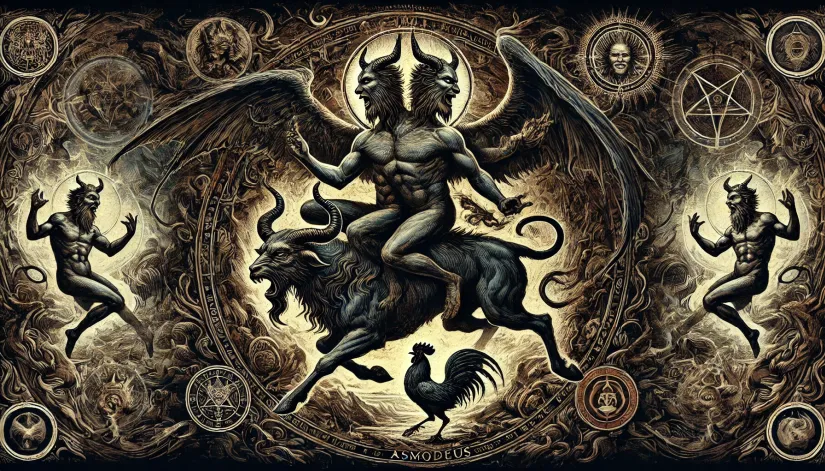Old Talmudic legends and Quranic texts mention how a demon usurped the throne of King Solomon.
This mysterious evil spirit somehow managed to deceive an entire kingdom by simply pretending to be the “son of David.” Who was this devil? Asmodeus. The King of Demons.
Known for his unparalleled cunning and pivotal role in some of history’s most captivating tales of deception, his origins and true nature remain an enigma.
Whether manipulating kings (like he did with Solomon) or corrupting the hearts of mortals, Asmodeus’ influence is pervasive. And his story spans centuries.
But who—or what—is Asmodeus, really?
In this article:
Historical and Religious Origins
The demon is mentioned across many civilizations’ religious and cultural traditions. But under many different names: Ashmedai, Asmoday, Sakhr, Aesham-daeva, Chashmodai, or Sydonay. All refer to the same deceitful entity.
Here’s the table for Asmodeus without the Description column:
| Attribute | Description |
|---|---|
| Aliases | Asmodai, Ashmedai, Sydonai |
| Titles | Prince of Lust, King of Demons, Demon of Wrath |
| Race | Fallen Angel, Demon |
| Pantheon | Abrahamic, Zoroastrian, Goetic |
| Personifies | Lust, Wrath, Revenge |
| Appearance | Three-headed (bull, man, ram), serpent tail, rides a dragon |
| Abilities | Temptation, manipulation, mind control |
| Equipment | Ring or seal, possibly symbols of lust or wrath |
| Associated Elements | Fire (symbolizing passion and wrath) |
| Gem/Crystal | Garnet, Ruby |
| Associated Figures | Lilith, Astaroth, other demons of passion or vice |
| Astrological Influence | Linked to Aries or Scorpio (passion, intensity) |
| Summoning Requirements | Seal of Asmodeus, rituals of protection, invocation of power |
| Equivalents | Set (Egyptian god of chaos), Ares (Greek god of war) |
| Affiliations | Hell, Ars Goetia, Zoroastrian mythology |
| Alignment | Chaotic Evil, associated with vices and temptation |
| Historical Mentions | Talmud, Testament of Solomon, Ars Goetia, Dictionnaire Infernal |
Let me know if you’d like any other changes!
Asmodeus in the Bible
Asmodeus is not mentioned in the canonical Bible. His presence is primarily found in extra-biblical texts and Jewish traditions rather than in the Bible itself.
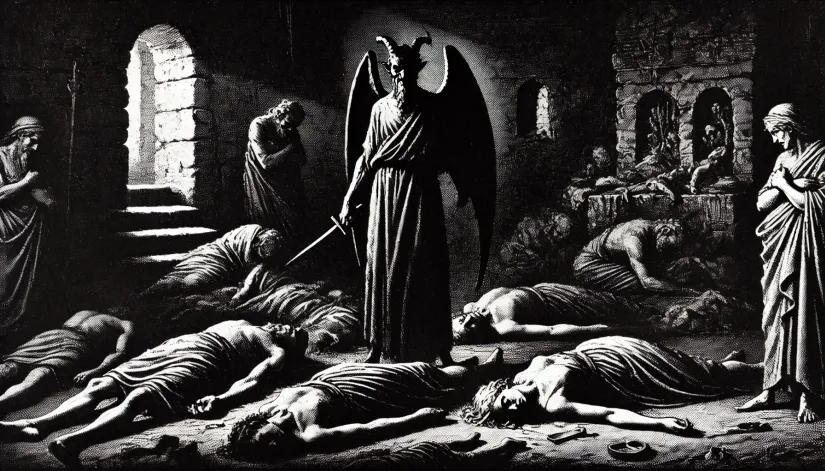
Asmodeus in Apocryphal Texts
Asmodeus is first prominently mentioned in the “Book of Tobit.” It’s an ancient text from the Apocrypha, dating back to the 3rd century BCE.
The story happens in the ancient city of Nineveh (within the Achaemenid Empire). Here, Asmodeus is a malevolent spirit whose jealousy drives him to claim the beautiful Sarah for himself.
The demon’s wrath manifests brutally—on each of her wedding nights, he murders her seven successive husbands, preventing their marriages from being consummated.
Tobit 3:8, NJB:
“She [Sarah] had been given in marriage to seven husbands, and Asmodeus, that worst of demons, had killed them before ever they had slept with her as man and wife.”
What does this type of behavior tell us? That Asmodeus is a force of destruction. A symbol of corruption and evil. Especially within the sacred bonds of marriage.
It’s worth mentioning that the “Book of Tobit” is part of the Catholic and Orthodox biblical canons. However, it’s not included in the Hebrew Bible and Protestant canon.
Interestingly, Asmodeus’ presence in Jewish literature extends beyond the Apocrypha.
For instance, in the “Talmud,” he is known as Ashmedai. But his traits are very similar. And his scheming character is clearly revealed in his interactions with key figures such as King Solomon (but more about that later).
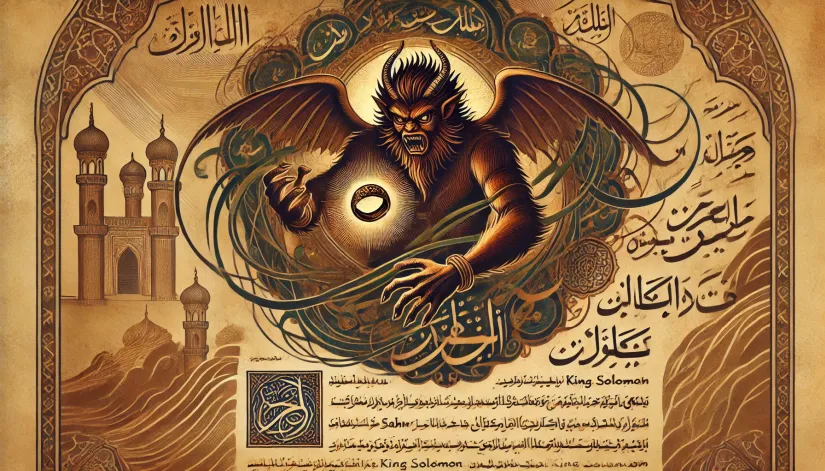
Asmodeus in Islam
In Islamic tradition, Asmodeus is called Sakhr—a powerful jinn. He appears in both the Quran and Hadith.
So, who is this Sakhr? Well, according to ancient Islamic texts, it is an unimaginably powerful supernatural entity. So powerful that it dared to challenge Prophet Solomon.
However, Solomon—known for his wisdom and control over the jinn— ultimately outwits and binds Sakhr using a magical ring, a symbol of divine authority.
The Hadith literature (dating back to the early Islam 7th-9th centuries CE) also features multiple references to Sakhr’s deceitful nature and eventual downfall.
Sahih Muslim 542:
“A strong demon from the jinn came to me yesterday suddenly to spoil my prayer, but Allah enabled me to overpower him. I wanted to tie him to one of the pillars of the mosque so that all of you could see him in the morning, but I remembered the supplication of my brother Solomon: ‘My Lord, forgive me, and grant me a kingdom that will not belong to anyone after me.’ So, he was driven away humiliated.”
SpookySight’s note:
The different mentions of Asmodeus (or his equivalent) in relation to King Solomon across different traditions—Talmudic legends, the Ars Goetia, and Islamic texts (as Sakhr in the Quran and Hadith)—do share some thematic similarities. However, they are not all identical and do not always refer to the same story.
Asmodeus in Persian and Babylonian Mythology
Zoroastrianism (an ancient Persian religion founded around the 5th century BCE) mentions Aesham-daeva. Aesham is a demon of wrath, rage, and devastation. The name itself can be interpreted as “wrath.”
He is one of the Daevas—malevolent spirits who oppose the order of Ahura Mazda, the supreme god of Zoroastrianism.
Avesta, Yasna 10.8:
“I drive away Angra Mainyu, I drive away Aeshma of the bloody spear, of the bloody club, who is of the seed of the Evil One.”
But what’s the link? How can you know that Aesham-daeva and Asmodeus are one and the same entity?
During the Babylonian Exile (6th century BCE), Jewish communities were exposed to Zoroastrian religious ideas due to their proximity to the Persian Empire (where Zoroastrianism was the dominant religion).
This cultural and religious exchange period likely facilitated the integration or transformation of specific deities and demons between the two practices.
It’s likely that the amalgam of religious ideas also facilitated the merger between the demon Ashmedai and Aesham-daeva.
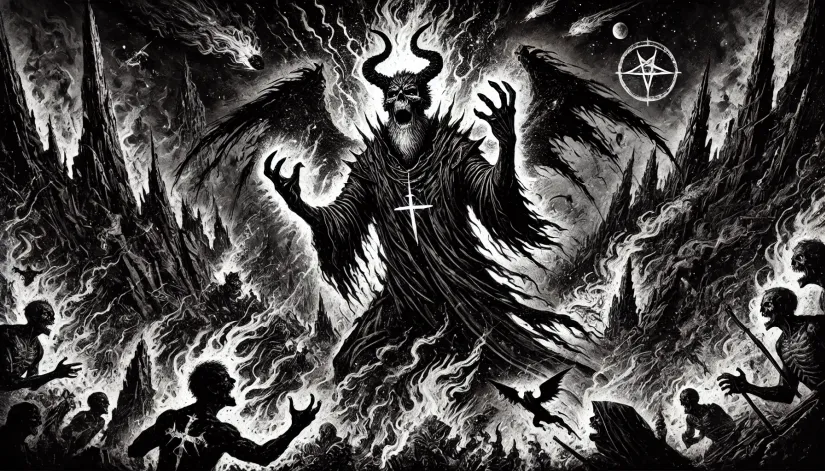
Asmodeus’ Role in Demonology
I don’t think anyone can argue that Asmodeus is one of the most prominent figures in demonology. Particularly within the esoteric rituals that flourished during Europe’s medieval and Renaissance periods.
His reputation as a powerful and cunning demon is well-documented in grimoires and religious texts that date back centuries.
Leader of the Infernal Hierarchy
Asmodeus is featured in the “Ars Goetia” (the first of the five books of the “Lesser Key of Solomon“), a grimoire compiled in the mid-17th century. However, the texts took inspiration from much older rites.
The “Lesser Key of Solomon” is an essential text for practitioners of Goetic magic. It details the complex rituals required to summon and bind demons using Solomon’s seals.
In “Ars Goetia,” Asmodeus is listed as the 32nd demon of Hell. According to the hierarchy of Hell proposed here, he’s also a powerful king who commands 72 legions of demons.
Lesser Key of Solomon, Ars Goetia:
“Asmoday, or Asmodeus, appeareth with three heads, whereof the first is like a bull, the second like a man, and the third like a ram. He rideth upon an infernal dragon, and beareth in his hand a lance with a banner. He is the first and choicest under the power of Amaymon, and goeth before all other.”
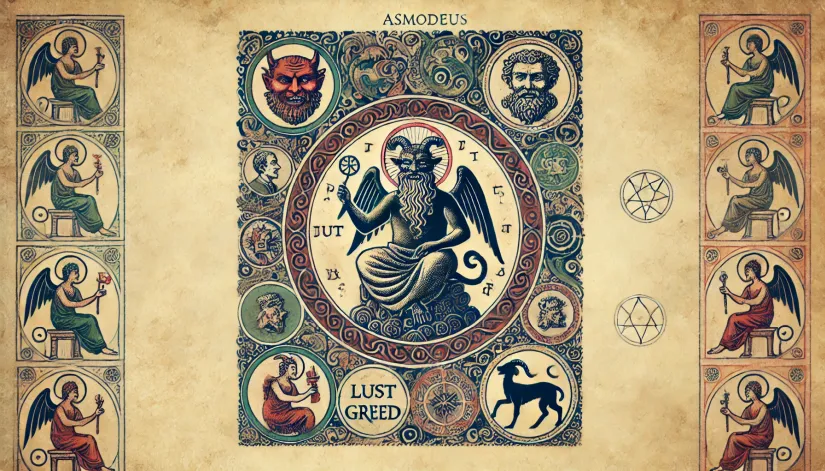
The Demon of Lust and Destruction
Asmodeus is often depicted as the demon of lust. He controls the sins of desire and weakness.
In the Christian religion, he is also classified as the demon responsible for the sin of fornication—one of the seven deadly sins.
This portrayal is notably documented in texts such as “The Lanterne of Light” (1409-1410). Here, he is identified as the demon that leads people into carnal desires and sexual corruption.
His primary objective is to destroy relationships (particularly between husbands and wives) by inciting lust, jealousy, and infidelity.
Testament of Solomon, 1st-5th century CE:
“I am called Asmodeus among mortals, and my business is to plot against the newly wedded, so that they may not know one another. And I sever them utterly by many calamities, and I waste away the beauty of virgin women, and estrange their hearts.”
Beyond his dominion over lust, Asmodeus is also associated with various other sins and vices. One such vice is gambling. Asmodeus can influence those who seek to gain wealth through chance and deception.
This association is particularly noted in “The Dictionnaire Infernal” (1818). Here, he is described as the demon of gambling and greed.
Interestingly, Asmodeus’ influence extends to fashion and trends, too. He inspires grotesque and nonsensical styles that distract people from spiritual pursuits and lead them toward vanity and pride.
Furthermore, Asmodeus is occasionally linked with vengeance and anger. Two powerful emotions that drive people to commit acts of violence and revenge.
His ability to inflame these passions is unmatched. It’s what makes him a formidable force in human sin. He corrupts through desire and the darker emotions that ultimately lead to destruction and chaos.
Consort and Companions
Asmodeus is often linked with Lilith (perhaps to enforce the demon’s association with the sins mentioned above).
The 13th century CE “Zohan” (Volume 1) mentions Lilith as the consort of the great demon Asmodeus. She seduces men and brings them into the embrace of the demonic, leading them away from righteousness.
Lilith is the mother of all demons and the first wife of Adam. She’s also depicted as Asmodeus’ consort in many demonological texts.
This pairing symbolizes the union of two dark forces. Lilith’s role as the infernal queen complements Asmodeus’ position as a demon of lust and vengeance.
Their relationship is particularly highlighted in medieval Jewish texts and later in Renaissance demonology. Lilith is portrayed as the embodiment of sexual corruption and nocturnal demons.
Asmodeus is her partner in seducing and corrupting mortals. Especially in matters of love and sexuality.
Their combined influence makes them a formidable force against purity and moral integrity. And their numerous demonic offspring continue their legacy of corruption and destruction.
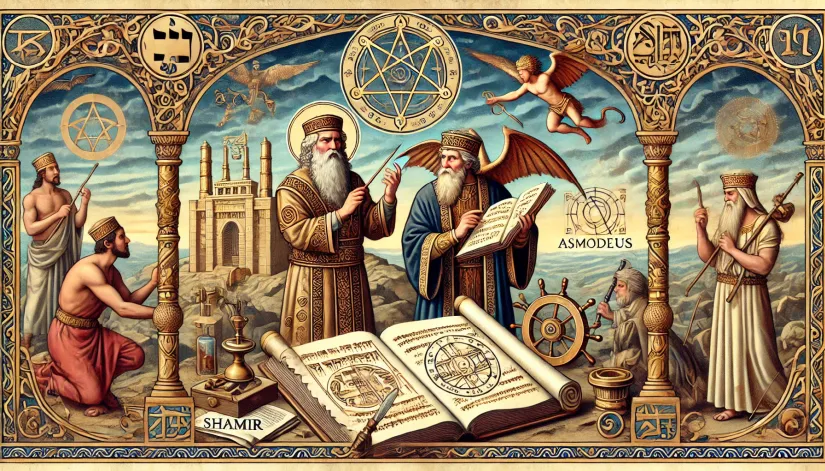
Asmodeus and King Solomon
We briefly mentioned the “relationship” between the demon and King Solomon above. It’s time to take a closer look at this fascinating story. It’s one of the most well-known tales in Jewish mythology.
The Quest for the Shamir and Binding of the Demon
In the Babylonian Talmud (Gittin 68a-b), Solomon’s interaction with Asmodeus starts when the king seeks the Shamir.
This Shamir is a mysterious creature (or perhaps some sort of legendary tool) capable of cutting stone without metal. Solomon needed Shamir to build his temple.
Solomon learns from his advisors that only Asmodeus knows its location. But the demon was clever. Not easy to trick.
So, to capture him, Solomon sends his chief general and most trusted friend—Benaiah Ben Jehoiada—with a chain inscribed with Shem HaMephorash (the ineffable name of God), a woolen cloth, a flask of wine, and a container of water.
Benaiah takes these magical items and finds the well where Asmodeus comes to drink. He covers it with the woolen cloth (which absorbs the water) and then digs a hole to drain the remaining water. In place of the water, Benaiah fills the well with the wine.
When the demon arrives, he is thirsty but cautious. At first, he hesitates to drink. He knows demons should not indulge in alcohol. However, his terrible thirst eventually overcomes his caution.
He drinks the wine and becomes intoxicated. Weakened and tired, the demon falls asleep.
While Asmodeus is incapacitated, Benaiah quickly binds him with the chain inscribed with the divine name. The power of the holy name renders Asmodeus unable to resist or escape. Benaiah successfully brings him to Solomon.
Using Asmodeus to Build the Temple
Once captured, Asmodeus is commanded to assist in constructing the Temple of Jerusalem (the Temple of Solomon)—a monumental task that requires both divine and demonic aid.
The Shamir (the magical creature or tool that Asmodeus revealed) plays a critical role in this process.
How so? The temple had to be built in accordance with divine instructions: the temple stones had to be hewn without the sound of metal tools.
1 Kings 6:7, KJV:
“And the house, when it was in building, was built of stone made ready before it was brought thither: so that there was neither hammer nor axe nor any tool of iron heard in the house, while it was in building.”
Under the strict oversight of Solomon, Asmodeus is forced to contribute his extensive knowledge of geometry, architecture, and magic to the building of the temple.
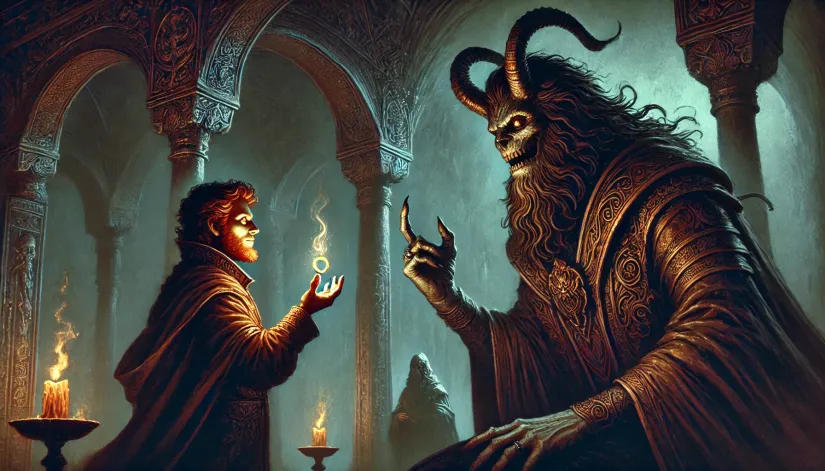
Asmodeus’ Betrayal
The tension between the demon and King Solomon grew as the temple construction project advanced. Asmodeus bided his time, waiting for the right moment to strike.
He soon noticed Solomon’s power over the demons was tied closely to his magical ring.
One day, Solomon expressed his doubt about the greatness of the demons, laughing at the fact that the King of Demons himself could be kept in chains by a mere mortal.
Sensing an opportunity, the demon asked Solomon to remove his ring and lend it to him. So that he could demonstrate his true power.
Gittin 68a:
“He said to him, ‘Give me your chain and ring, and I will show you my strength.’ He gave them to him, and Ashmedai swallowed them and grew until he placed one wing in the sky and one wing on the earth. He then hurled him a distance of four hundred parasangs.”
As soon as the ring was handed over, Asmodeus swallowed it, regaining his full strength. The Talmud details how the demon’s size and power expanded dramatically, allowing him to throw Solomon far away from his kingdom—sending him into exile.
Solomon’s Fall and Redemption
With Solomon cast out, Asmodeus assumed his identity and took over the throne, effectively deceiving the entire kingdom.
But what about the true king? Well, stripped of his divine protection and authority, he was forced to wander the earth, experiencing the life of a beggar and enduring countless hardships.
During his exile, Solomon reflected on his errors and the consequences of his overreliance on supernatural forces. Solomon wandered from city to city, proclaiming, “I, Kohelet, was king over Israel in Jerusalem” (Ecclesiastes 1:12), but was not recognized.
The “Midrash” (Yalkut Shimoni, I Kings 192) captures this period of Solomon’s life. Here, we read of his long journey of introspection and repentance.
Ultimately, Solomon’s return to power is marked by two factors: divine assistance and his wisdom.
Some accounts suggest that Solomon was guided by divine intervention to a place where he found the ring. In this version, God, having witnessed Solomon’s repentance and suffering, decides to restore him to his rightful place.
In other versions, Solomon’s loyal followers or allies who remained faithful to him despite his downfall helped him in his quest to find the ring.
Expelling Asmodeus and Reclaiming the Throne
Once Solomon reclaimed his ring, he was once again in possession of the divine power that allowed him to command demons.
The Talmud notes succinctly that upon retrieving the ring, Solomon returned, confronted Asmodeus, and expelled him from the throne.
Gittin 68b:
“Solomon, having returned to Jerusalem, sought his ring. Upon finding it, he approached Ashmedai, cast him out, and was restored to his throne.”
Solomon’s wisdom and divine favor are fully restored in this final act. He uses the ring’s power to banish Asmodeus, who is once again rendered powerless by the name of God inscribed on the ring.
The demon is forced to flee, and Solomon resumes his rightful place as king.
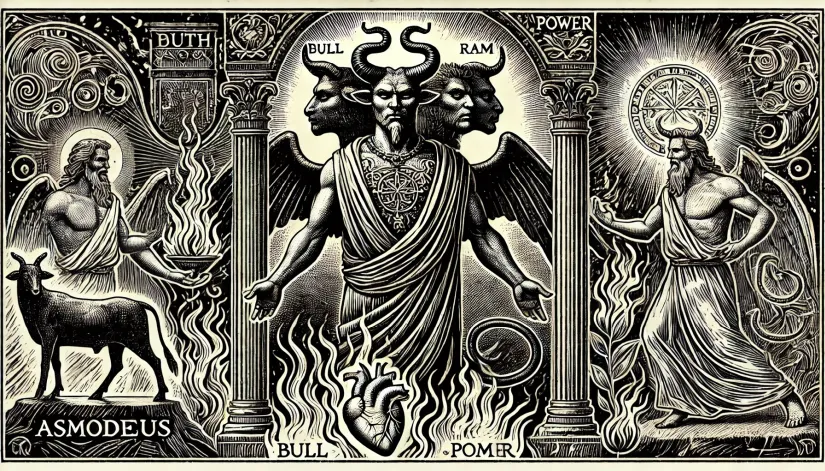
Asmodeus’ Physical Form and Abilities
The demon’s abilities (which extend far beyond mere physical strength) make him one of the most formidable demons in the infernal hierarchy.
How Does Asmodeus Look Like?
Asmodeus is a grotesque and fearsome figure. His form reflects his chaotic and destructive nature, combining elements from various beasts and mythological monsters.
Lesser Key of Solomon, Ars Goetia:
“[…] three heads—one of a bull, one of a man, and one of a ram. He rides upon an infernal dragon, and has the tail of a serpent and the feet of a rooster.”
Asmodeus has three heads, each symbolizing different aspects of his power:
- Bull’s Head: Strength, aggression, and his destructive power
- Man’s Head: Cunning, intelligence, and ability to manipulate and deceive
- Ram’s Head: Stubbornness, ferocity, and connection to lust and carnal desires
He also has rooster feet. Which is often a symbol of vigilance and, in some interpretations, a connection to the underworld.
His serpent’s tail is emblematic of deceit, temptation, and his ability to bring about sin and ruin.
And finally, Asmodeus is riding an infernal dragon. Dragons in mythology are often associated with chaos. His connection with this creature underlines his dominion over such forces.
Master of Shapeshifting
Asmodeus can shapeshift. He is a metamorph who can alter his appearance at will. This way, he can easily deceive and manipulate mortals (and even other demons).
In fact, we’ve mentioned his shapeshifting powers when we discussed the “Testament of Solomon” and the “Lesser Key of Solomon” (“Ars Goetia“) above.
As pointed out, he used his transformative powers to assume different guises, tricking an entire kingdom into thinking that he was the “son of David.”
Knowledge and Occult Mastery
The King of Demons is not terrifying due to its hideous form. He is also feared for his vast knowledge of the past, present, and future, and his ability to manipulate matter—transforming one substance into another at will.
Testament of Solomon:
“Asmodeus […] knows the secrets of the earth and the heavens. He can turn metal into gold and reveal the hidden treasures beneath the earth.”
His absolute mastery over occult knowledge includes the hidden secrets of nature—such as alchemy, geometry, and astronomy.
Manipulation and Mind Reading
Closely linked to his ability to deceive, Asmodeus is also a master of manipulation and mind reading. He can uncover mortals’ darkest secrets and use these secrets to corrupt and lead them astray.
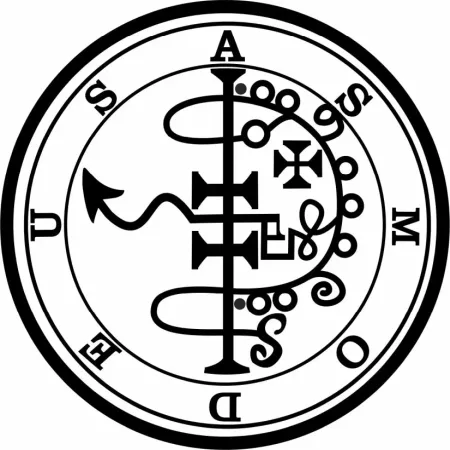
The Sigil of Asmodeus
The Sigil of Asmodeus was first mentioned in “Ars Goetia,” along with 71 other sigils of the demons that King Solomon purportedly controlled.
The sigil of Asmodeus is intricate. It merges geometric patterns and arcane symbols within a circular framework. In many depictions, it is enclosed within two circles. The outer circle sometimes contains the word “Asmoday,” a variant of the demon’s name.
The inner sigil (often interpreted as a twisted arrow or a cross-like figure) is believed to hold his very essence (or power).

